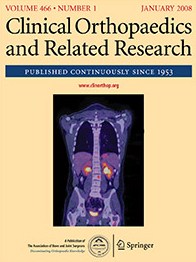
ARTHROPLASTY
No benefit of L2 paravertebral block over lumbar plexus block for motor function after THA
This report has been verified
by one or more authors of the
original publication.
Clin Orthop Relat Res. 2014 May;472(5):1475-81. doi: 10.1007/s11999-013-3393-9
60 patients undergoing total hip arthroplasty were randomized to either a lumbar plexus block (LPB) or a paravertebral nerve block (PVB) at L2 as a method of postoperative analgesia. The purpose of the study was to evaluate the L2 PVB as an alternative to LPB, as it has been suggested that motor function may be benefited through using L2 PVB. Patients were monitored for the first 24 postoperative hours for cumulative morphine consumption through intravenous patient-controlled analgesia, postoperative pain at rest and on movement, and weakness of the quadriceps and hip flexors. Results demonstrated that while the effect of L2 PVB on postoperative pain was similar to that of LPB, motor function was not significantly difference between groups. Additionally, mean morphine consumption over the first 24h was significantly increased in patients who received the L2 PVB
Unlock the full ACE Report
You have access to {0} free articles per month.Click below to unlock and view this {1}
Unlock NowCritical appraisals of the latest, high-impact randomized controlled trials and systematic reviews in orthopaedics
Access to OrthoEvidence podcast content, including collaborations with the Journal of Bone and Joint Surgery, interviews with internationally recognized surgeons, and roundtable discussions on orthopaedic news and topics
Subscription to The Pulse, a twice-weekly evidence-based newsletter designed to help you make better clinical decisions
Exclusive access to original content articles, including in-house systematic reviews, and articles on health research methods and hot orthopaedic topics
Or upgrade today and gain access to all OrthoEvidence content for just $1.99 per week.
Already have an account? Log in


Subscribe to "The Pulse"
Evidence-Based Orthopaedics direct to your inbox.
{0} of {1} free articles
Become an OrthoEvidence Premium Member. Expand your perspective with high-quality evidence.
Upgrade Now













































































